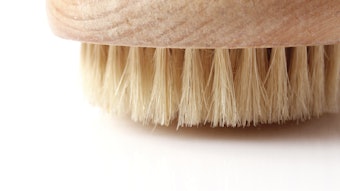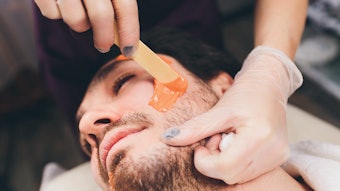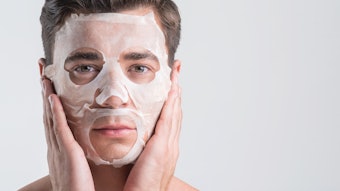
Most of the skin on the body is typically protected from the UV exposure that the face is subjected to on a daily basis; however, this body skin has its own special needs. The physiological differences of skin—depending on its location and the fact that skin on the body is often neglected—make body-specific products a necessity. Although the skin conditions typically treated on the face also occur on the body, their management varies when they present on the body. For these reasons, the skin on the body is best served with products formulated specifically to address these unique needs.
Special skin
The basic structure and function of the skin remains the same regardless of where it is on the body, but small differences play a considerable role in how treatment plans should be designed. The most significant differences are in cell turnover rate, sebaceous activity and epidermal thickness.
Cell turnover rate. The cell turnover rate in body skin is slower than in facial skin because of dryness, neglect and decreased environmental exposure. The combination of these factors typically leads to a reduced ability for the skin on the body to properly desquamate.
Sebaceous activity. This is much lower in the skin on the body versus that of the face, primarily because the body’s sebaceous glands are located predominantly on the face and scalp. This can make dry and impacted skin more of an issue on the body.
Epidermal thickness. This varies depending on the location of the skin. The facial epidermis is approximately 0.12 mm thick, while the skin on the body is thicker, closer to 0.60 mm. The proliferation of bacteria and hyperkeratosis becomes more of an issue on the body because the skin is thicker, creating a more deoxygenated environment.
Hidden challenges
Although many of the same skin conditions that appear commonly on the face also plague the body, people often simply cover them up rather than seeking treatment. Some are embarrassed at the prospect of having body parts treated by a skin care professional, and others are unaware that body-specific products and treatments are even available. These types of body-targeted products are widely available for the treatment of acne, hyperpigmentation, keratosis pilaris and atopic dermatitis (eczema).
Body acne. This is incredibly common, particularly in teenagers and in more humid climates. The hyperkeratinized skin on the body creates the ideal environment for Propionibacterium acnes (P. acnes) bacteria to proliferate. Increasing exfoliation, reducing inflammation and keeping the area well-cleansed and hydrated are key to clearing acne breakouts on the body. Salicylic acid and other anti-inflammatory and keratolytic topical ingredients help to reduce cell impaction and decrease inflammation within the follicle, while controlling the proliferation of acne-causing bacteria.
Hyperpigmentation. This commonly affects the hands, arms and chest. Subject to daily UV exposure, these areas are often neglected when it comes to sunscreen use. Melasma is typically discussed as a facial challenge, but can also appear on the forearms, while post-inflammatory hyperpigmentation will develop anywhere surface trauma has taken place, not just on the face. Chemical peels that combine trichloroacetic acid (TCA), and alpha hydroxy acid (AHA) can dramatically increase results. Because of the thickness of body skin, higher percentages of active ingredients can be employed for these treatments. Home-use products that contain hydroquinone, undecylenoyl phenylalanine, and phytic, kojic and azelaic acids are also recommended for daily use. The combination of professionally applied treatments with home-use products is the best way to achieve even pigmentation.
Keratosis pilaris. A common complaint found on the tops of the thighs, backs of the arms and buttocks, keratosis pilaris often appears in the winter and is characterized by small, roughly textured bumps. It is caused by cellular impaction around the hair follicle, which forms a plug. Keratosis pilaris is best treated with moisturizing lotions containing exfoliating agents and humectants. Again, because the skin is thicker and less prone to inflammation, higher percentages of acids, such as lactic acid, can be used to reduce the predominant hyperkeratinization.
Atopic dermatitis (eczema). Typically affecting the backs of the knees, insides of the elbows and the face, atopic dermatitis can occur anywhere on the body. Flareups are often brought on by stress or topical irritants, such as shampoo or soaps. Dry, scaly, red, itchy patches that can crack and weep are common signs of eczema. It is often associated with allergies, so finding the trigger greatly reduces onset. Anti-inflammatory topicals that provide a large amount of hydration and occlusion are beneficial. Physician referral may be necessary in extreme cases, because prescription medications may be needed. In atopic dermatitis that is not open and weeping, AHAs, beta hydroxy acids (BHA) and other ingredients that help to increase hydration and encourage cellular turnover can be added to a client’s regimen.
Specialized products
It is common for clients to invest in quality products for their faces, while not paying much attention to the needs of the skin on their bodies. This is especially true of cleansing and hydrating products. Additionally, corrective treatment products for addressing specific skin conditions, such as hyperpigmentation or acne, are much more commonly purchased for the face and not the body. Clients working to clear skin conditions on the body typically experience significantly faster results when using specialized body products and treatments.
Cleansing. Bar soaps typically used on the body can often have a pH of as high as 10, leading to irritation and dryness. Because the skin on the body is already dry, cleansers designed for use on the body with a balanced pH (4–6) should be used. To combat specific conditions, targeted treatment ingredients such as salicylic acid or benzoyl peroxide for breakout-prone skin, and kojic and azelaic acids for hyperpigmentation, can be incorporated into cleansers. Cleansing products containing active ingredients are only beneficial when the ingredients are left in contact with the skin long enough to take action: approximately 2–5 minutes. One exception to this rule is benzoyl peroxide for acne; its action is instant, and it can be rinsed off the skin without a waiting period.
Hydration. Daily skin hydration is imperative for the body, as it is with facial skin. Body-specific hydrators are often heavier than facial moisturizers and may contain corrective ingredients, such as lactic acid or phytic acid, as well as humectant and occlusive agents. Humectant ingredients attract water moisture and occlusive ingredients that hold it within the skin. Recommended humectants include lactic acid, panthenol, urea, sodium hyaluronate and glycerin. Good choices for mild occlusion are jojoba extracts, squalane, silicones, shea butter and botanical oils.
Anti-inflammation. Because inflammation is a common contributing factor to many conditions on body skin, anti-inflammatory ingredients are important additions to products designed specifically for this use. BHA, aloe vera, bisabolol and evening primrose seed oil are all beneficial options for soothing skin on the body.
Exfoliation. Gentle exfoliation is important for keeping the skin on the body free of impaction. This exfoliation can be mechanical, using polyethylene or jojoba beads, although ground fruit pits and other jagged media should be avoided because they can cause excessive irritation. Chemical exfoliation is also highly effective for treating most of the common skin conditions of the body. TCA, AHAs and resorcinol are good choices. Lactic acid exfoliates while simultaneously providing hydration, reducing bacteria and inhibiting pigment deposition. Salicylic acid (BHA) and resorcinol reduce the impacted stratum corneum common to skin on the body. This minimizes impactions and calms inflammation, which is beneficial for eczema, acne and keratosis pilaris.
Improve client satisfaction
Body-specific products offer a unique opportunity to improve overall client satisfaction, as well as increase your skin care facility’s profitability. The skin on the body is different than that of the face, and using products designed especially for this thicker, drier and more impacted skin will help to accelerate results. Make clients aware of the specific needs of the skin on their bodies, and discuss the options you have available for treating these skin challenges. This added service is a simple way to accomplish healthy skin on the entire body.
Joan Tomeu has been a registered nurse for more than 30 years and has served as an advanced educator for PCA Skin since 2004, training estheticians, physicians and other nurses about skin biology, chemical peels, ingredient knowledge and medical devices.










